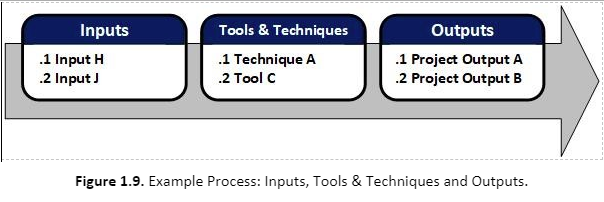
The project life cycle is managed by executing a series of project management activities known as project management processes.
Every project management process produces one or more outputs from one or more inputs by using appropriate project management tools and techniques.
The output can be a deliverable or an outcome. Outcomes are an end result of a process.
Project management processes apply globally across industries. Project management processes are logically linked by the outputs they produce.
Processes may contain overlapping activities that occur
throughout the project. The output of one process generally results in either:
-
* An input to another process, or
-
* A deliverable of the project or project phase.
Figure 1.9 shows an example of how inputs, tools and techniques, and outputs relate to each other within a process, and with other processes.
The number of process iterations and interactions between processes varies based on the needs of the project.
Processes generally fall into one of three categories:
-
* Processes used once or at predefined points in the project.
-
The processes Develop Project Charter and Close Project or Phase are examples.
-
* Processes that are performed periodically as needed.
-
The process Acquire Resources is performed as resources are needed. The process Conduct Procurements is performed prior to needing the procured item.
-
* Processes that are performed continuously throughout the project.
-
The process Define Activities may occur throughout the project life cycle, especially if the project uses rolling wave planning
-
or an adaptive development approach. Many of the monitoring and control processes are ongoing from the start of the project, until it is closed out.